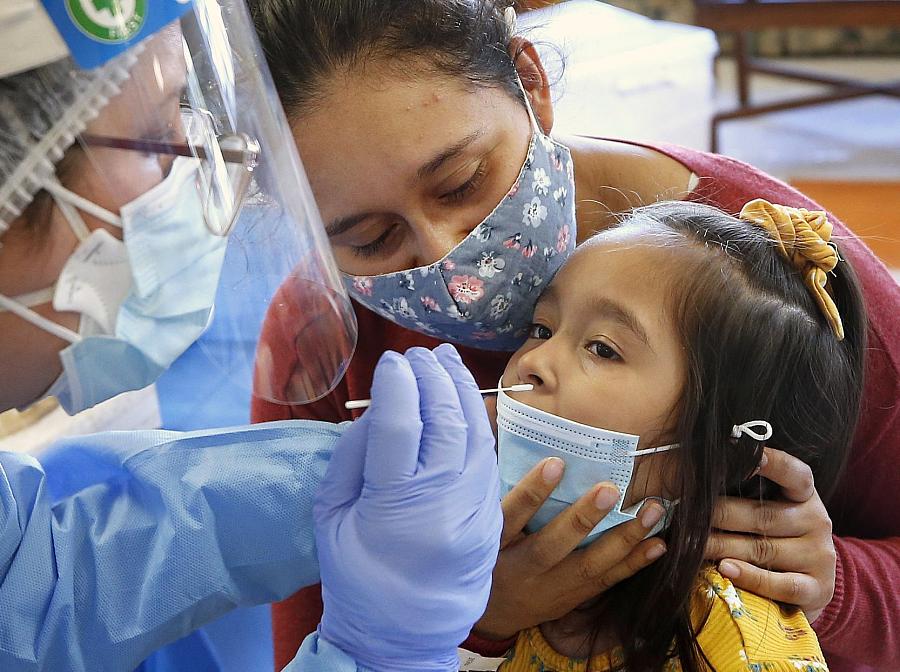Virginia’s public health system faced funding cuts for decades, leaving it unprepared to limit COVID’s toll on Latinos

(Photo: Alexa Welch Edlund/Richmond Times-Dispatch)
In 2020, billions of dollars from the federal government headed toward health departments in hopes of managing the century’s greatest public health crisis. Virginia received hundreds of millions.
The Civil Rights Act of 1964 requires any recipient of federal funds to provide competent and timely translated materials for non-English speakers, but limited oversight on whether agencies follow through on doing so has meant language access for decades has faltered.
In a pandemic where accurate information was critical in knowing how to not get sick, the impact was deadly. Within three months, Latinos — a population that made up less than 10% of Virginia’s population — became almost half of the state’s infections. A year after the first person with coronavirus was recorded in Virginia, Latinos were still the most likely to be infected, hospitalized or die from COVID-19.
And the deaths were among people in the prime of their lives. A study from the Virginia Department of Health found that Latinos who were 35 to 44 years old were dying at 11 times the rate of whites in the same age group. Hospitalizations were 2.6 times greater.
Even though Spanish is the second-most spoken language and Latinos have been the fastest-growing population in the state, there was no guarantee a Spanish version of medical information would be available on the VDH site simultaneously with English ones — outside of Google Translate, which the Department of Labor’s Civil Rights Center advises against when it comes to vital documents.
The issue prompted community organizations with pre-existing relationships with Latino communities to take on the additional burden of translating executive stay-at-home orders and where to get tested. Spanish radio was relaying details on school closures. Children were explaining preventative measures to their monolingual parents.
If there weren’t enough resources for Spanish speakers, there were even less for the hundreds of thousands of Virginians who spoke a language other than English and Spanish at home.
Meanwhile, the millions earmarked for health departments — which in the early months of the pandemic was delayed and unpredictable — prioritized short-term solutions as if it’d be enough to stave off the chronic underfunding of public health that impeded the ability for agencies to respond in the first place.
There was an immediate need for more contact tracers as the administrative staff in charge of onboarding processes saw little growth. Most contact tracers didn’t speak Spanish as Latinos accounted for a bulk of cases, hindering the efficiency of a critical pillar in identifying spread. It was well known that outreach and trusted messengers were needed, but like so many other states, Virginia was building the infrastructure in real time for something that to do successfully needed years and not days.
Then as state officials repeatedly said equity was at the forefront of their COVID strategy, the race and ethnicity data that was necessary to pinpoint where disparities were occurring wasn't comprehensive enough to execute those promises.
Data gaps continued into 2021, when more than half of vaccinations by race and ethnicity were not recorded. One of the first insights into how poverty determined who lived and who died from COVID wasn’t released until June of this year.
Experts in public health said without sufficient data — which extends into recording income, access to food and housing and neighborhoods where people live — it’d be impossible to fully address the impact.
Limited English proficiency for cases, hospitalizations and deaths are also not regularly reported, leaving the full scope of how the virus devastated immigrants — many of whom were essential workers without the paid sick leave that allowed others to quarantine if sick — largely unknown.
And while money from federal, state and a variety of grants has poured in to aid communities the pandemic has debilitated, knowing what the metrics of success look like and whether the funds are helping confront a structural issue is much more complicated.
These glaring problems were well documented in the years leading up to the pandemic. Health care coverage among Latinos was already falling severely behind. Ten years ago, a quarter of Latino children were living in poverty. From 2013 to 2019, they were the least likely to graduate high school in four years — a factor that influences future access to medical resources.
Advocates pressed potential solutions such as widened language access and outreach. Research showed in a public health crisis, Latinos would be one of the most vulnerable without it. VDH, for years, requested money to improve its data systems and ramp up funding for disease prevention.
But policymakers largely ignored the pleas for help until it was too late to do more than react, depicting a pattern that occurred in disasters like 9/11 and the H1N1 pandemic. And even though history has shown the consequences of underfunding public health, some of the first cuts when in a recession such as 2008 are still to these departments. Virginia’s public health agencies haven’t fully recovered from then — a preventable failure leaving them ill-equipped to minimize COVID’s inequitable toll on Latinos quickly enough.
The flood of federal money has helped adopt temporary fixes to help. Through the 2021 National Fellowship, I hope to highlight what happens when that runs out and legislators choose again not to fill the funding hole before the next public health crisis arrives.

